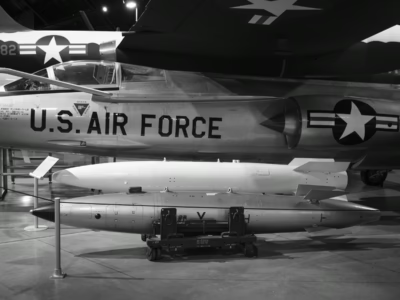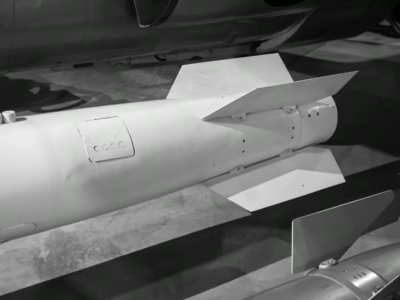Mark 43 Bomb
A small nuke to carry on small planes

Explosive Power
70 kt or 1 Megaton
Hiroshima Equivalent Factor
Up to 67x
Dimensions
13.6 ft. x 18 inches
Weight
2116 lbs.
Year(s)
1961–1991
Purpose
A tactical bomb carried by a large variety of aircraft
About THE MARK 43 Bomb
The United States, with the full knowledge and tacit approval of the President, dropped two nuclear bombs on Japan in 1945.
During the Korean War, General Douglas MacArthur strongly advocated that the US military attack China, which supported North Korea, with nuclear weapons. He formally requested permission to strike thirty-four targets, but his request was not approved. Late in the war, he was given control over four nuclear bombs to use at his discretion. He did not use them.
During the Taiwan Strait Crisis in 1954, President Eisenhower threatened to attack China with nuclear weapons—China, at this point, did not have any of its own. His senior military advisors recommended a nuclear strike. The next year, as the crisis continued, senior civilian leadership threatened a nuclear strike, as did Eisenhower.
In 1961, the city of West Berlin, still politically divided from its eastern half since the end of World War II and a key symbolic location for both adversaries in the Cold War, was threatened with forcible annexation by the Soviets. East Germany, which fully surrounded both halves of Berlin, was a Soviet satellite state, and a wall was built to cut West Berlin off from supplies and reinforcements. Senior advisors to the President advocated for the use of nuclear weapons as tensions mounted and small, infantry-level nuclear rifle units were moved into position.
In 1962, as the Cuban Missile Crisis unfolded, the Air Force moved many of its bombers and fighter aircraft within range of the island, intent on destroying the Soviet nuclear missiles that had been discovered there. The Air Force Chief of Staff, Curtis LeMay, the famed former head of Strategic Air Command, pressed Kennedy strongly to order an attack and angrily lashed out when out of earshot of Kennedy when that permission was not granted. Scores of nuclear-armed bombers were kept in the air day and night, Nike-Hercules missiles were rushed to Florida to destroy any incoming Cuban or Soviet planes, that might be attempting to deliver a heretofore unrevealed enemy atomic bomb. Air Force ICBMs were readied, and thermonuclear bombs were loaded onto attack planes which sat on the ground as the pilots and crews played board games, awaiting their go-orders.
The F-100 was one of those planes, the Super Sabre, a single-seat high-speed fighter bomber. You can imagine a sleek Mark 43 hung under one wing, its white paint blending with the white of the fuel tanks and the silver of the plane’s fuselage and wings.
The Mark 43 bomb had several distinct advantages in an attack on Cuban SA-2 surface-to-air missile sites, on the Soviet Ilyushin Il-28 bombers now on Cuba, or upon the missile installations themselves. As a relatively lightweight bomb it could be carried by a diverse roster of aircraft, multiplying its usefulness. It was aerodynamic and could be carried externally without requiring the plane to fly slowly, which would make attacking aircraft extraordinarily vulnerable. A plane armed with a Mark 43 had the option to approach at a low altitude, popping up at the last minute and releasing the bomb upwards, not only helping the plane to avoid radar and anti-aircraft fire and missiles with its low approach, but the bomb’s arcing trajectory up and then down would offer the plane valuable seconds with which to make its escape from the nuclear blast of its own bomb.
What made most of these advantages possible was that the Mark 43 was a low-yield weapon, which is to say a low explosive-power bomb. In a world with bombs ranging up to the bewildering-high twenty-five megatons of the Mark 41, this smaller, variable-yield bomb maxed out at one megaton and could be set much lower. If aimed with a high level of accuracy—something a small fighter-bomber could accomplish better than a high-flying B-52—a one-megaton explosion could be as effective in destroying a target as a much more powerful detonation. (Indeed, sixty-five years later, the newest ICBM in the US arsenal, the upcoming Sentinel, will have a yield of less than half of the Mark 43 and the most powerful bomb currently in the nuclear inventory, the Mark 84, is about even up with the Mark 43 in explosive power.)
The F-100 sitting there, waiting, was not to be the first plane to strike in Cuba. Conventional forces would act first. The Air Force, already well into its preparations for attacking Cuba due to the military built-up on the island in the weeks prior to the photographs of the clandestine missile tents, would pave the way using non-nuclear weapons for a full-scale ground invasion. The nuclear bombs would be at the ready, presumably to respond to any launch of a Cuba-based nuclear missile, or if the invasion foundered, leaving the US forces disorganized and exposed.
Or if a Soviet submarine was caught by the US blockade, cut off from communications with Moscow for days, and was attacked by eleven Navy destroyers and at least one aircraft that were enforcing a blockade around Cuba. The sub’s captain may have then perceived that war had broken out, that World War III was underway. And if the sub’s commanders, all three in agreement, had loaded and fired one of their nuclear torpedos at the USS Randolph, an aircraft carrier, then the Mark 43 would have been used.
And if the Soviets on Cuba, in addition to their nuclear missiles, had secretly brought one hundred tactical nuclear weapons to the island, and if Moscow had put them under the full control of the local Soviet commander, and if they had used those weapons against the invading forces, perhaps even destroying Miami or other cities on the US mainland, then the Mark 43, and so many other weapons, would have answered those counter-attacks on our troops, on our Navy, on our country.
The Soviets, cowed by our forceful response and recognizing our continued defensive vigilance and military readiness to protect our interests in Berlin and elsewhere in Europe and around the world, would read the signals we were sending by our calibrated attack on Cuba, and they would interpret the situation correctly. Though we had obliterated one of their allies, we did, notably, refrain from attacking them directly, and they would see our DEFCON 2 status, note our 1436 bombers on alert, one-eighth in the air, would discern our 145 ICBMs ready-to-go, as well as our ready force of 916 refueling tanker aircraft which would make perfectly clear that we could strike from afar and strike deep.
And then the Russians wouldn’t do a thing.
Gallery


Nukemap
NUKEMAP is a web-based mapping program that attempts to give the user a sense of the destructive power of nuclear weapons. It was created by Alex Wellerstein, a historian specializing in nuclear weapons (see his book on nuclear secrecy and his blog on nuclear weapons). The screenshot below shows the NUKEMAP output for this particular weapon. Click on the map to customize settings.

Videos
Click on the Play button and then the Full screen brackets on the lower right to view each video. Click on the Exit full screen cross at lower right (the “X” on a mobile device) to return.
Further Reading
- Wikipedia
- The invaluable Pfeiffer Collection has Sandia’s 1968 “History of the Mk 43 Bomb.”
- A nice photo of the B-59 Convair Hustler in mid-flight with at least three practice Mark 43 bombs attached. Note the large centerline pod which could contain fuel as well as a high-yield thermonuclear bomb. Click on the photo to enlarge.
- This is a short video of a F-104 Starfighter “tossing” a Mark 43, a technique that allows the attacking plane additional time to exit the blast area. Of course, the smoke trail was utilized here simply to help viewers track the course of the bomb as it flies upwards (for a surprising amount of time) before slowing and beginning its descent.
- A graphic depiction of the relative sizes of various nuclear bombs. Scroll down for the “Mk 43.”
- During the Vietnam War, in December of 1965, an A-4E Skyhawk rolled off the deck of the aircraft carrier USS Ticonderoga during a training exercise. Attached to it was a live Mark 43 thermonuclear bomb set to its one-megaton setting. The pilot, plane, and bomb were never seen again. The incident became public in May of 1989. Far and away the best account of the story is from Delbert Mitchell, who was part of the crew that loaded the bomb onto the plane, published in 2019 by the Naval Institute Press. Note that many versions of this story claim that the plan was to launch the Skyhawk, which would immediately circle and land again. Mitchell says nothing about launching the plane, only that it would be loaded onto the carrier’s catapult before being brought back for unloading.
- Note the long user review by James S. Little, at Amazon, where he claims he was a witness to the accident and shares his recollections (e.g. that the sea was not calm on that day).
- At the link, scroll down to “0800058 – U.S. NAVY TRAINING FILM – MARK 43 AND MARK 57 WEAPONS – SHIPBOARD HANDLING, INCLUDING AIRCRAFT LOADING” for a text description of the matching video, above.

